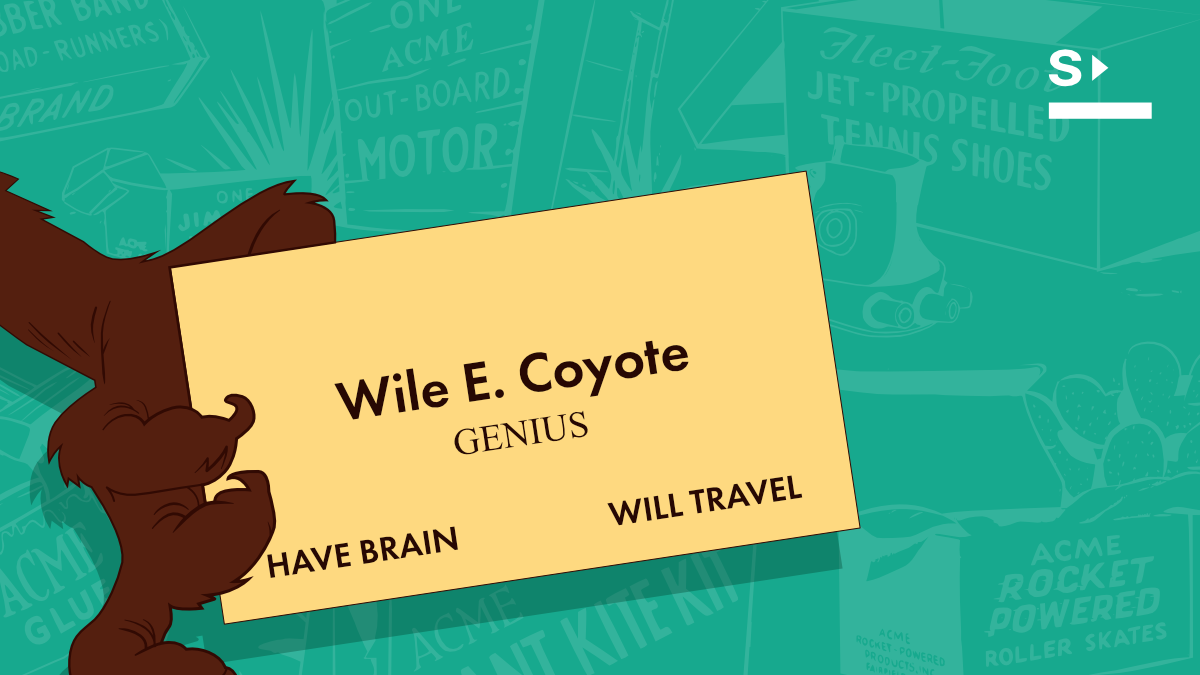Lessons from Wile E. Coyote: What startups can learn from cartoon failures
Wile E. Coyote is one of my favorite cartoon characters. Wile is a genius (as his business card states). He has a vision and works hard to succeed by following a well-designed plan. His Plan A? A rocket-powered roller skate to catch his prize. Like many entrepreneurs, he’s devoted to his idea and convinced it will work. But as we’ve seen, no amount of commitment guarantees a catch, and each attempt is full of failures.

Know your RoadRunner (or customer)
The Lean Startup process focuses on quickly validating assumptions before investing too heavily. It is a way of avoiding Wile E.’s mistake of charging ahead without checking for gaps in his knowledge. This approach helps bypass the fatal pitfall of building products that no one needs. For Wile E., rather than spending all his resources on a jet-propelled unicycle to run as fast as the RoadRunner, he’d be better off starting by observing and identifying pain points (like “What makes a roadrunner slow down?”).
Learning Over Perfection
The Wile E. Coyote and RoadRunner series (1949 – 2014), consisted of 49 episodes in which Wile E. achieved 0% success using approximately 343 traps. Among these: explosives (30 attempts), archery bows, catapults (18 attempts), boulder drop (14 attempts), rockets (5 attempts), anvil drop (3 attempts) or combinations of the above. As Wile, many entrepreneurs often reuse ideas that failed in previous shots or return to the drawing board for yet another untested scheme.
Lean startups operate on a “Build-Measure-Learn” feedback loop, where each iteration brings new insights. This process encourages learning from each failure, adjusting tactics and focusing on sustainable growth rather than seeking a perfect, one-time win. For Coyote, adopting this cycle would be beneficial by evaluating why his previous attempts failed and gradually improving his methods.
MVP instead of a Rube Goldberg machine1
Wile’s complicated traps, famously ordered from the ACME Corporation2, are a cornerstone of cartoon slapstick humor. Rocket-powered roller skates, spring-loaded boots and tornado seeds. Despite their sophisticated designs and elaborate mechanisms, these gadgets lead to comical disappointments. In an analogue way many startups, even in their early stages, invest in developing numerous features making their products unnecessarily evolved.
The Lean Startup methodology emphasizes launching a Minimum Viable Product (MVP), a simplified testable product version, to get feedback fast. For Wile, a simple box-and-stick trap would be enough to learn quickly if RoadRunner even stops for bait! Testing and validating each step would save him from countless painful wipeouts.
Pivoting from Plan A to a Plan that doesn’t cause harm.
Chuck Jones – the mastermind behind Wile E. Coyote and RoadRunner, to maintain the unique charm and consistency of these cartoons, established a set of specific “rules” that governed the behavior of the characters, and the overall universe they inhabited. The third rule states: “The Coyote could stop anytime — if he were not a fanatic.”
Entrepreneurs should be open to pivoting—changing the plan based on the feedback. Lean is about avoiding blind commitment to a single vision without real-world validation. It’s about staying agile, gathering data, and tweaking the plan. For Wile E., this would mean the difference between endless drops from a cliff and finally achieving a goal, whether catching RoadRunner or following a new, more promising path.
- A Rube Goldberg machine is a chain reaction device designed to perform a simple task in a complicated way. Named after the American cartoonist Rube Goldberg, who was famous for illustrating these types of elaborate mechanisms in his comic strips.
↩︎ - The name “Acme” is a bit of a joke itself, as it comes from the Greek word “acme” (meaning the “peak” or “zenith”)—implying the supply of high quality products. In early 20th-century America, many businesses used the name “Acme” because it was a way to appear first in alphabetical listings. The Acme brand was widely used ironically in cartoons since its products were notoriously unreliable. ↩︎
